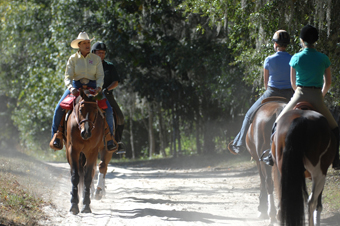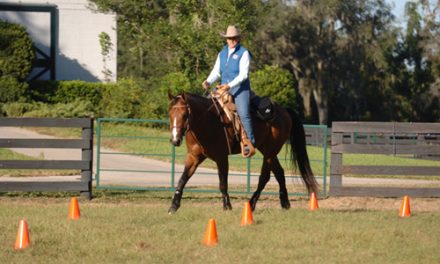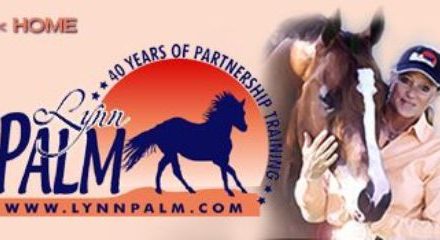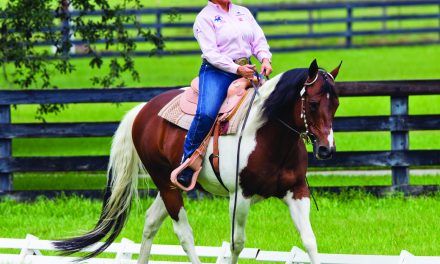BUILDING A PARTNERSHIP WITH YOUR HORSE
 This month we are starting a new series of articles on “training outside the box.” The “box” refers to those confined areas, such as arenas and paddocks, where many riders spend training time. It’s time to get out of the “box” and learn to train outside in order to have more fun. Remember, however, that safety always comes first!
This month we are starting a new series of articles on “training outside the box.” The “box” refers to those confined areas, such as arenas and paddocks, where many riders spend training time. It’s time to get out of the “box” and learn to train outside in order to have more fun. Remember, however, that safety always comes first!
In 1976, I trained my first National and AQHA World Champion horse, Lecanto Raider, on the trails surrounding the Northwood community of Eagle River, WI. He was trained 85% of the time on the trails, and only 15% in an arena. He was a happy horse in his training because training outside the box: (1) helps maintain a horse’s awareness and attitude because he has new environments to experience; (2) helps keep both the horse’s and rider/trainer’s interest because being outside adds variety to lessons; and (3) usually encourages a horse to go forward, even a horse that normally is lazy and lethargic.
The most common question I am asked relates to training and trail riding outside the box. Riders are concerned about losing control of their horse and what to do if the horse is disobedient, bucks, or rears. These responses from the horse usually cause the rider to become fearful and apprehensive about getting hurt. We need to address these issues in order to avoid them outside so that training and riding outside remains fun and safe.
The best way to avoid these problems before they arise is to exercise the horse before going outside in order to release what I call the horse’s “inner energy.” When a rider takes his/her horse into a new environment, the horse will almost always become overly sensitive and be higher strung in the new surroundings. Riders tend to expect that the horse will work and perform outside in the same way as he does at home. This is not the reality, especially for horses that have not been “seasoned” by going different places and traveling many miles over many years.
Any fit and healthy horse will have some level of “inner energy” that must be released before he can concentrate on the task at hand. The level of “inner energy” can vary in different horses, but it is always there in high strung or sensitive horses, and some lazy horses as well. When a horse has not released his “inner energy,” he will be thinking “fast.” Remember, you will be safe and able to teach a horse only if the horse is thinking “slow.” You can recognize when a horse is thinking “fast” if he is turning his head and moving his ears quickly and if his movements are fast.
One of the best ways to help the horse release this inner energy is through what is called “forced exercise.” There are three types of forced exercise: (1) longeing, (2) liberty work, and (3) ponying. Of these three, the most important to master is longeing. Personally, I feel longeing is the most important form of forced exercise because you can use it anytime and anywhere. All you need is a good fitting halter, a cotton longe line, and a lunge whip. The lunge whip should have a minimum length of three feet with a tassel that is one to two feet longer than the whip part. The tassel should end with a little “snapper.” This strong woven material makes a snapping/popping noise to encourage the horse to move away from it and to move forward.
There are a few rules to follow when longeing. If the horse is already bridled and needs to be longed, simply fit the halter over the bridle. Attach the longe line either over the nose (for more response) or under the chin. A longe line that ends in a chain will be more severe than a simple cotton line with a snap end.
Before longeing with a bridle on, it is very important to secure the reins so that the horse cannot get them over his head, step on them, or get a leg between them. To do this, place the halter over the bridle. Attach the longe line, with or without chain end, to the horse’s halter either by threading it over the nose or under the chin. If you are riding in Western tack, bring the reins under the pommel and through the hole under the pommel, and tie them in a knot. Loop the knotted end over the saddle horn. Make sure that the reins are not so loose that the horse could put his nose down on the ground or get a leg through them. Be equally careful not to tie the reins too short either as it will restrict the horse’s head carriage. If you are riding in English tack, the easiest way to handle the issue of reins is simply to take them off.
In the next article, I will explain how to “read your horse” to avoid problems before they happen.
My E-Book, Training Outside the Box, is an excellent resource on this subject. Part 5 of my Longevity Training Video Series provides you with detailed instruction on the art of longeing. For more information on these and other Palm Partnership Training™ resources and schools, visit our website at www.lynnpalm.com or call us at 800-503-2824





